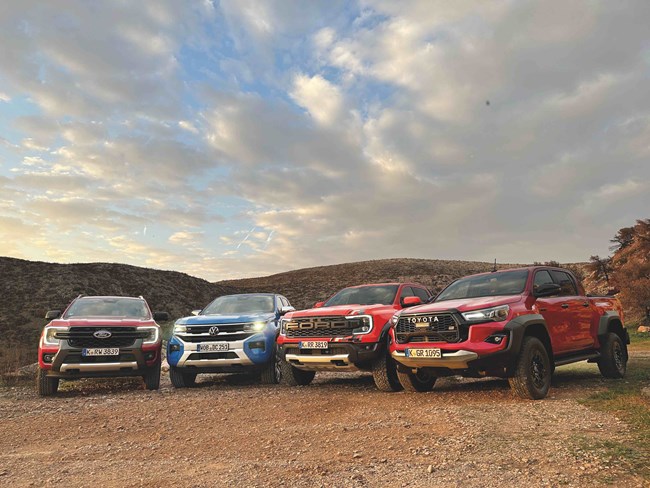- ETRUX launches new Ford E-Transit Trizone
- Renault gives UK debut to Master E-Tech at CV Show
- Isuzu D-Max long-term test – Latest Report
- Isuzu D-Max V-Cross Steel Edition revealed
- IVOTY Report: Stellantis explores the hydrogen proposition
- New Maxus EVs include eDeliver 5 van
- Used LCV values reach six-month high
- ADVERTISEMENT FEATURE: IVECO Daily Mission Awards 2024 Q2 Round-up: Grounds Maintenance & Forestry
- Stellantis Pro One electric vans review
- Mitie adds 5,000th EV to fleet
IVOTY Report: Picking the best of the bunch
Date: Tuesday, November 21, 2023 | Author: George Barrow
The biennial International Pick-up Award returns this year and jury member George Barrow runs the rule over the contenders.

The International Pick-Up Award is a biennial event that brings together the latest pick-ups launched in the period after the previous award and those that are production ready and soon to go on sale.
The previous judging event, which includes significant amounts of on-road and off-road driving, was held in Croatia where the Toyota Hilux took the honours, giving it the right to be declared the pick-up of the year for 2022 and 2023. The latest judging evaluation, held just outside of Athens, Greece, included two brand-new heavyweights of the pick-up sector after the 2022 launch of the Ford Ranger and its co-developed sibling, the Volkswagen Amarok. Also joining the party is the Ford Ranger Raptor and a 2024 model of the Toyota Hilux GR Sport II.
Its an interesting line-up that poses the immediate conundrum of how to separate the Fords and Volkswagen models. By virtue of being a performance pick-up, built in a separate facility and engineered with motorsport-grade suspension and a very non-commercial vehicle-like V6 petrol engine, the Raptor is suitably different enough to be a model in its own right. Likewise, the Toyota Hilux GR Sport II, an enhanced development of the incumbent champion.
Picking apart the differences between the Ford Ranger line-up and the Volkswagen Amarok range is a little more difficult. Co-development in the van world has seen numerous models share platforms, resulting in a number of joint-winners in the International Van of the Year Award – most recently the Renault Kangoo and the Mercedes-Benz Citan last year. Although the pick-up trucks differ in terms of their appearance and driving setup, they are fundamentally the same vehicle at their core. It’s for that reason that the jury decided to count them as one combined entry.
Starting with the Raptor, it stands alone in the competition for its performance and abilities. With 289hp, the 3.0-litre V6 petrol engine offers performance not previously seen in the pick-up segment, and significantly ups the game from the previous generation model using the stock 210hp 2.0-litre diesel engine still found in the Ranger line-up. Aggressive styling with flared wheel arches and F150 looks are just part of the package, as underneath the skin the Raptor’s suspension is the attribute that most justifies the truck’s existence and abilities.

Fox 2.5in Live Valve dampers provide position-sensitive damping to ensure the Raptor is both comfortable on the road but able to endure extreme off-roading. The Raptor is equally at home on the motorway as it is on a dirt track, but it excels when it comes to treacherous off-roading. During the test, it was the only vehicle able to scale a rock boulder formation without so much as a slip of the wheels. While all the trucks were capable of overcoming some considerable obstacles, it’s the manner in which the Raptor does it that most impresses. By virtue of having a locking front differential – in addition to the locking rear diff, found on all other participants – the Raptor could climb any obstacle thrown at it without so much as slipping a wheel or deviating from its course. The Raptor’s Baja mode is also enough to make even novice drivers feel like off-road heroes on suitable loose surfaces making it a hard candidate to look beyond simply for its sheer enjoyment and driving capabilities. There is then, of course, the elephant in the room when it comes to payload. With just 652kg allowed in the rear and a 2.5-tonne towing capacity, rather than the more usual 3.5-tonnes, it doesn’t necessarily fit the bill for everyone – not least because the VAT isn’t recoverable in the UK.
The rest of the Ford Ranger models provide a more sensible and varied approach to the segment. From the entry-level XL model through to XLT, Wildtrak, Wildtrak X, Tremor and Platinum, there’s a model for every customer and occasion. Giving the range a real strength in depth. With a choice of 2.0-litre four-cylinder bi-turbo or 3.0-litre V6 diesel engines, the Ranger has unprecedented levels of torque, up to 600Nm. While, as standard, it doesn’t have the trick suspension of the Raptor it does have a very composed ride and direct responsive steering. If you plan to use the Ranger for more extreme pursuits, the Wildtrak X and Tremor models are available with more off-road focused Bilstein dampers, but having tested the standard setup back-to-back you really must be on rough terrain and really pushing to benefit. Those models are also only available with the 2.0-litre engine, but it’s the engine that feels more at home in the Ranger – bearing in mind it is shared with the Amarok. The 2.0-litre is a tried-and-tested engine in the Ranger line-up, carried over from the previous model. It’s powerful enough, with plenty of torque and considerably more efficient than the V6. The additional weight and potency of the V6 does perhaps make it more engaging off-road where there’s more immediacy in the power delivery and more of it. The V6 diesel is a very welcome addition to the Ford Ranger line-up but the power plant feels more at home in the Amarok.
Volkswagen’s range is almost as comprehensive as Ford’s with entry-level Amarok trim followed by Life and Style – a natural competitor to Wildtrak given that it is the crossover point in the range where the 2.0-litre and V6 diesel are both available. Higher up are the Panamerica and Aventura, the latter of which is more aligned to Ranger Platinum. Slightly softer suspension, ideal for highway use and lighter assisted steering that disguises the bulk of the heavy pick-up each characterise the Amarok’s driving. The changes are subtly different to the Ranger when driven in isolation but back-to back you really notice the differing styles of the two products. Like the V6 Wildtrak, the more off-road orientated Panamerica devours the dirt roads around Athens while also capably climbing hills and rocky obstacles, albeit with the same issues brought on by the front wheels spinning.
Last but not least there’s the Toyota Hilux GR Sport II. The second generation of the Gazoo Racing inspired pick-ups this time has many more upgrades, including cosmetic tweaks from all black details like the sports bar, bumpers and grille, to red coil springs and seat belts. But like the Raptor it’s the under the skin changes that look to define the GR Sport II, with 20mm ride height increase as well as an increased track of 140mm at the front and 155mm at the rear. The wider stance together with the new front and rear axles improve the Toyota’s handling to such an extent that it is in some ways the best handling of all the assembled models when on a smooth asphalt surface. The lighter Hilux kerb weight makes it agile and you can place it precisely into a corner where you find huge amounts of grip. There’s a slight numbness around the centre point of the wheel as initial turn in on the first few degrees of steering fails to communicate itself to the chunky new tyres, but after that it’s direct and purposeful. Unfortunately, for all it’s on-road merits the same can’t be said for its off-road performance, where the once smooth riding suspension jolts, crashes and shimmers over rough surfaces. Perhaps expecting Raptor-like ride quality is a step too far – but on dusty, bumpy dirt tracks strewn with small rocks, the Amarok and Wildtrak make better companions.
A question of perspective
Determining which vehicles are eligible for the award and if they should be considered is no easy task, so I’ll try to give some insight into how the jury came to their decisions. The group represents a number of countries across the world – from markets where pick-ups are strictly working tools to places where they’re more often used as leisure vehicles. The countries also have small and large markets, from Portugal and Belgium to the UK and South Africa.
For me as the UK representative, my interpretation of what a pick-up truck should be is largely based on the 1,045kg payload requirement needed to reclaim the VAT. While the market of around 50,000 pick-up trucks per year might not all be for commercial use, the fact that the majority meet this criteria makes them commercial vehicles and as such should be fundamentally practical. Other regions aren’t quite the same. Norway, for example, has no such payload requirements, and hefty taxation on all ICE models makes the price difference on a diesel Ranger almost as much as the Ranger Raptor. As a result, 60% of sales are for the performance pick-up.
George Barrow is the UK jury member for the International Van of the Year Award.
View The WhatVan Digital Edition


